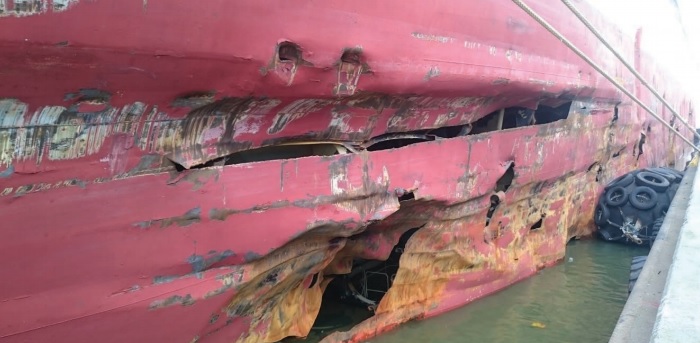On 20 November 2016 at about 0850, the general cargo ship Saga Sky collided with the rock carrying barge Stema Barge II, approximately 2 miles off the south coast of the UK, as a result from adverse weather conditions created by Storm Angus. As a consequence, 2 subsea power cables were severed. The UK MAIB issued an investigation report on the accident.
The incident
Stema Barge II was being used to supply rock armour to a sea defence project commissioned by Network Rail. The barge had been anchored close to the subsea cable runs of Interconnector France-Angleterre 1, a high voltage power supply system operating between the UK and France.
After Saga Sky had passed through Dover Strait in the south-west traffic lane, the weather deteriorated significantly with the approach of Storm Angus. The south-westerly wind and tidal stream significantly reduced the ship’s progress. The master attempted to turn the ship to starboard to steer a reciprocal course and run with the weather until the storm abated. The effect of the wind acting on the ship’s cranes and aft superstructure overcame the turning moment of the rudder and prevented the turn from being completed. Despite maintaining propulsion, Saga Sky was blown broadside over a distance of approximately 7.4nm while the master continued with his attempts to turn the vessel to starboard until it collided with Stema Barge II.
The combination of wind and tide propelled Saga Sky, beam on to the wind, at speeds of up to 9kts, and even after deploying both anchors the ship continued to move under the effects of the storm. Both vessels dragged their anchors and two of the four subsea cable pairs that made up the interconnector were severed.
Safety issues
- The marine licence granted by the Marine Management Organisation (MMO) referred only to the sea defence works and did not formally take into account operations away from the foreshore.
- In referring the marine licence application to the MCA, the MMO provided no detail on the objectives of the MCA’s review or what it required the MCA to assess.
- That an out of date chart had been used for the method statement and had passed through the project planning phase, including the marine licence application process, without being questioned demonstrates a lack of focus on navigational risks.
- Currently, there are no prescribed minimum distances from submarine cables that ships in UK waters should apply when anchoring or conducting other underwater activities.
- The MCA has no statutory powers to impose criteria for the protection of subsea infrastructure.
- On passage, Saga Sky’s weather fax and Navtex receiver were both defective, which limited the vessel’s ability to receive live and forecast weather information.
- In the absence of vessel-specific guidance as a reference for assessing the effect of forecast weather conditions would have on Saga Sky’s manoeuvrability, the master was reliant solely on his own knowledge and experience.
- Even if the French tug Abeille Languedoc had been tasked as early as 0700, when the master decided to turn Saga Sky to run down sea, it would not have arrived in time to prevent the vessel from colliding with Stema Barge II. It is also unlikely that it would have been able to prevent Saga Sky from running aground had the ship avoided Stema Barge II.
- The lack of any suitable tug assets in the vicinity of Dover meant that Anglo-Eastern Ship Management Ltd would not have been able to engage a commercial salvor in time to avert Saga Sky’s collision (or possible grounding).
- Ships’ crews who encounter difficulty in severe weather conditions within navigational constraints may have insufficient time in which to arrange for a commercial tug in the normal way (given commercial and availability considerations).
- A ship’s anchors will be used in extremis in an attempt to prevent it from running aground (regardless of any restrictions on anchoring) with consequent potential damage to subsea cables and other seabed infrastructure.
- Given the volume of traffic using the Dover Strait and the apparent absence of local commercial salvage assets, it would be appropriate to review the availability of emergency towage provision in the Dover Strait, as has already been done for north and north-west Scottish waters.
Recommendations
Following investigation, the UK MAIB advised the following:
1. The Maritime and Coastguard Agency have been recommended to commission a study to review the full range of emergency response assets available in the Dover Strait area, including a reassessment of the need for a dedicated emergency towing capability.
Furthermore, in conjunction with the UKHO, the MCA have been recommended to justify the need for regulatory powers which could be applied, where appropriate to ensure vessels comply with the International Hydrographic Organization recommendations with respect to anchoring in the vicinity of submarine cables.
2. The Marine Management Organisation have been recommended to improve their marine licence application process by:
- highlighting precisely what activities the particular marine licence is to cover, including any specified risks to be assessed in the submission.
- clearly stipulating a requirement that the latest nautical publications are referred to in the submission.
- ensuring that its primary advisors are clear on the objectives of their respective reviews and the elements of the application they are required to assess.
3. The UK Hydrographic Office have been recommended to adopt the International Hydrographic Organization’s recommendation for responsible authorities to set a minimum distance, nominally 0.25nm, from submarine cable, within which ships should avoid anchoring or conducting other underwater activities.
4. Anglo-Eastern Ship Management Ltd have been recommended to enhance their shipboard procedures by developing vessel-specific guidance that its masters can refer to, in order to estimate the effect forecast heavy weather conditions could have on their ships’ manoeuvrability.
Explore more herebelow:


































































